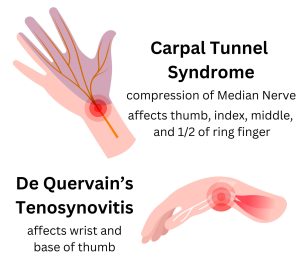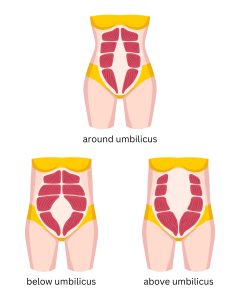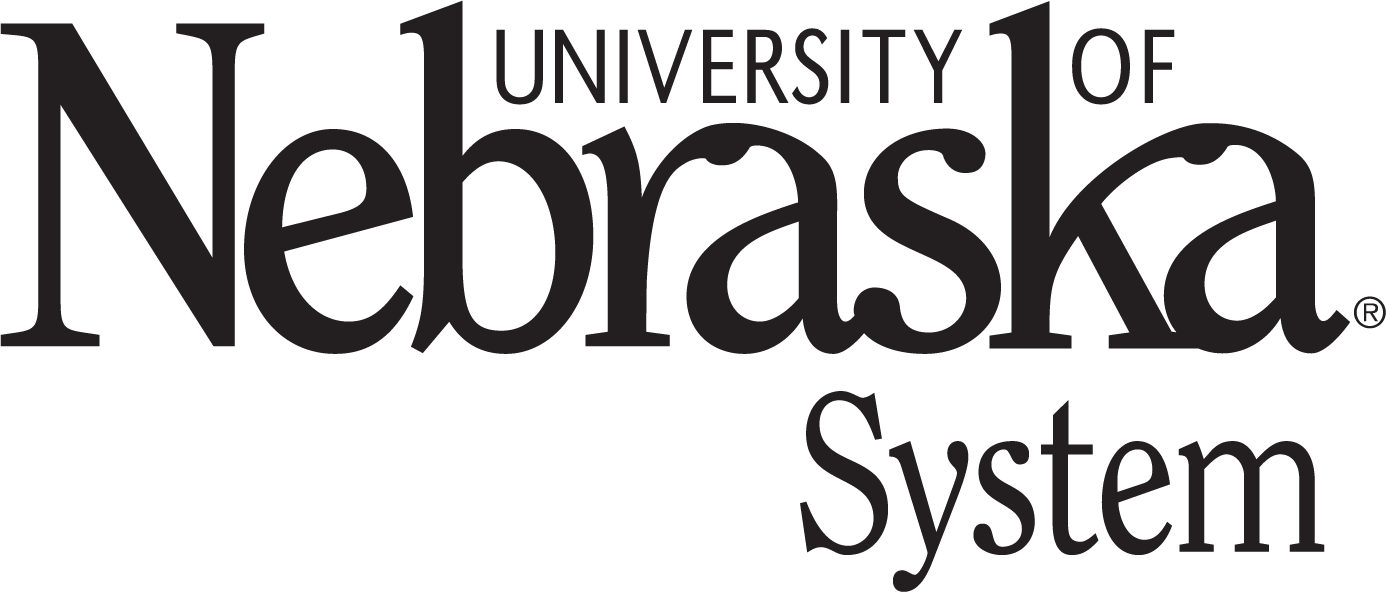17
Postpartum Conditions
Many new mothers often experience musculoskeletal problems after childbirth. The demands of caring for a newborn frequently force them into uncomfortable positions, especially during breastfeeding. In addition to the physical strain caused by maintaining these awkward postures, new mothers regularly lift, cradle, and hold their infants, which can increase discomfort. Without proper guidance on posture and positioning techniques, women may suffer from various painful symptoms resulting from these daily activities, potentially leading to long-term musculoskeletal issues. Additionally, factors such as fatigue, hormonal changes, and the physical stress of recovery can further complicate these challenges.
Musculoskeletal Challenges
The most commonly reported musculoskeletal issue among women is back pain, followed closely by pain in the hands and wrists. Prenatal and postpartum mothers face an increased risk of upper extremity (UE) conditions, including Carpal Tunnel Syndrome, De Quervain’s Tenosynovitis, and Tendinosis.
 Treatment for upper extremity conditions includes posture retraining, education, strengthening exercises, and orthotics. Women, in particular, can benefit from custom-fit orthoses to reduce the risk of nerve compression or De Quervain’s syndrome, along with activity adaptation. In a level 3 prospective cross-sectional study, 67.4% of 383 pregnant women reported experiencing hand and wrist pain, likely due to fluctuations in prolactin levels and fluid retention. Spending extended periods in improper positions, combined with prolonged swelling, may contribute to the development of peripheral neuropathy. Incorrect positioning, such as while breastfeeding or holding a newborn, can initially affect the wrist, followed by the elbow and shoulder. The pain associated with De Quervain’s tenosynovitis can worsen with the frequent actions of spreading the thumb and wrist when lifting a baby throughout the day. Although surgery may provide quicker relief from symptoms, it may impose limitations on the hand’s functionality during the healing process, thereby impacting the new mother’s ability to breastfeed or lift her child. Occupational therapists can assist new mothers in selecting and using breastfeeding pillows, bath stands, and appropriately designed baby carriers to help reduce the likelihood of pain.
Treatment for upper extremity conditions includes posture retraining, education, strengthening exercises, and orthotics. Women, in particular, can benefit from custom-fit orthoses to reduce the risk of nerve compression or De Quervain’s syndrome, along with activity adaptation. In a level 3 prospective cross-sectional study, 67.4% of 383 pregnant women reported experiencing hand and wrist pain, likely due to fluctuations in prolactin levels and fluid retention. Spending extended periods in improper positions, combined with prolonged swelling, may contribute to the development of peripheral neuropathy. Incorrect positioning, such as while breastfeeding or holding a newborn, can initially affect the wrist, followed by the elbow and shoulder. The pain associated with De Quervain’s tenosynovitis can worsen with the frequent actions of spreading the thumb and wrist when lifting a baby throughout the day. Although surgery may provide quicker relief from symptoms, it may impose limitations on the hand’s functionality during the healing process, thereby impacting the new mother’s ability to breastfeed or lift her child. Occupational therapists can assist new mothers in selecting and using breastfeeding pillows, bath stands, and appropriately designed baby carriers to help reduce the likelihood of pain.
Diastasis Recti
 During pregnancy, all women experience a condition known as diastasis recti, which involves the separation of the rectus abdominis muscles. This separation occurs along the midline of the abdomen as a result of stretching or tearing due to the growing uterus. Remarkably, after giving birth, around 60% of women may still have visible diastasis recti. Although this condition is generally not associated with pain, some women report experiencing unusual sensations or irritation in the abdominal area.
During pregnancy, all women experience a condition known as diastasis recti, which involves the separation of the rectus abdominis muscles. This separation occurs along the midline of the abdomen as a result of stretching or tearing due to the growing uterus. Remarkably, after giving birth, around 60% of women may still have visible diastasis recti. Although this condition is generally not associated with pain, some women report experiencing unusual sensations or irritation in the abdominal area.
In addition, many women notice a pronounced bulge or distension in their abdomen, particularly when they eat or drink, which can be concerning. To assess diastasis recti, a simple self-examination can be performed by lying on your back and attempting a crunch. During this movement, you may see the abdominal muscles protrude in a tent-like shape, indicating the presence of the separation. Link for self-examination of diastasis recti.
Fortunately, diastasis recti can be effectively addressed through the guidance of an occupational therapist. The therapist develops a customized treatment plan focusing on retraining the abdominal muscles and enhancing their strength. This often involves progressively incorporating various exercises, such as core and glute workouts this strengthens the abdominal region and improves overall core stability and support. Certain exercises like crunches can worsen diastasis recti. Through this comprehensive approach, women can regain strength, functionality, and confidence in their bodies post-pregnancy.
Predisposing factors:
- 33 years of age and older
- More than one pregnancy
- Large baby
- C-section
Dyspareunia (painful sexual intercourse)
New mothers frequently encounter a myriad of unforeseen challenges as they transition into this new chapter of their lives, with one notable hurdle being the changes in their intimate relationships. The profound physical and emotional transformations that come with motherhood can significantly impact a woman’s sexual well-being. Factors such as hormonal fluctuations, physical discomfort from childbirth, fatigue from sleepless nights, and the overwhelming responsibility of caring for a newborn may contribute to feelings of frustration and confusion. As they navigate this unfamiliar landscape, many women may grapple with shifting desires, diminished libido, or anxiety surrounding intimacy, all of which can cast a shadow over their once vibrant sexual lives, leaving them seeking guidance and support in reclaiming that aspect of their relationships.
Dyspareunia is defined as painful sexual intercourse, is among the most common sexual dysfunctions experienced following childbirth. This condition is characterized by persistent or recurrent genital pain that occurs before, during, or after sexual activity. Factors contributing to postpartum pain during intercourse include the type of delivery, episiotomy, lactation, pre-existing dyspareunia, parity, and the continuation of sexual activity after giving birth. Women may experience a range of symptoms following childbirth, including increased fatigue, perineal pain, urinary incontinence, depression, and changes in sexual function. The anatomy and functioning of the pelvic floor undergo significant changes during and after delivery, which can lead to potential sexual dysfunction. Additionally, women may encounter a decreased libido, vaginal discomfort, and difficulties achieving orgasm. The average prevalence of dyspareunia is 35%, increasing to 42% within the first two months postpartum, 43% from two to six months postpartum, and then declining to 22% at six to twelve months postpartum.
Perinatal and postpartum depression
New mothers often navigate a challenging emotional landscape, where the joys of motherhood collide with a wave of intense feelings. The mix of joy, anxiety, and exhaustion forms a rich tapestry of emotions that can bring moments of deep love while simultaneously throwing them into vulnerability and worry. This delicate balance of excitement and fear creates a whirlwind that leaves them feeling both elated and overwhelmed as they face the constant demands of their new role.
Perinatal depression can disrupt a woman’s routine, impacting sleep and activities with her baby. Occupational therapists offer mindfulness techniques and cognitive strategies to reduce stress and anxiety during this transition. What sets occupational therapy apart is its focus on incorporating the woman’s habits, roles, and routines into interventions to improve her quality of life.
Women who are breastfeeding often face the dilemma of whether to take medications for postpartum depression, as they may be concerned about the impact on their nursing infants. In this context, an occupational therapist serves a critical role in helping mothers adapt and thrive in their new responsibilities and identities as caregivers.
Occupational therapists provide tailored support, assisting new mothers in navigating the complexities of breastfeeding techniques, enhancing family dynamics, and understanding hormonal fluctuations that accompany the postpartum period. They offer guidance on essential activities of daily living (ADLs), such as personal hygiene and meal preparation, as well as instrumental ADLs (IADLs) like managing household tasks and social interactions. Furthermore, occupational therapists help mothers cultivate healthy relationships and prioritize self-care, including strategies for obtaining restorative sleep amidst the challenges of caring for a newborn.
With their specialized training in various feeding techniques and coping mechanisms, occupational therapists equip new mothers with valuable tools to adapt their lifestyles and routines in response to the demands of a newborn. The arrival of a baby can lead to significant changes in daily habits, social roles, and personal rituals, and occupational therapists are instrumental in guiding mothers through this transformative period, ensuring they feel confident and satisfied in their evolving roles.
Postpartum Posttraumatic Stress Disorder (PPTSD)
Some women may also experience postpartum posttraumatic stress disorder (PPTSD) following a difficult pregnancy or traumatic childbirth. Approximately 9% of women encounter some form of PPTSD, often due to factors such as unplanned cesarean sections, the use of vacuum extractors or forceps during delivery, premature births, extended stays in the neonatal intensive care unit (NICU), or other mental health issues that arise during the birthing process.
References:
Casey, E. & Ribaudo, A. (2023, July 28). Diastasis recti: What it is and how to fix it. Hospital for Special Surgery.https://www.hss.edu/article_diastasis-recti.asp
Parti, A. (2019, March 29). The role of occupational therapy in the postpartum period to improve occupational performance and role satisfaction. Occupationaltherapy.com. https://www.occupationaltherapy.com/articles/role-occupational-therapy-in-post-4725
Media Attributions
- Carpal Tunnel Syndrome
- diastasis recti
